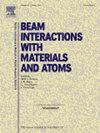Geant4 simulation of electron beam penetration behavior in textile artifacts matrix
IF 1.4
3区 物理与天体物理
Q3 INSTRUMENTS & INSTRUMENTATION
Nuclear Instruments & Methods in Physics Research Section B-beam Interactions With Materials and Atoms
Pub Date : 2025-01-06
DOI:10.1016/j.nimb.2024.165603
引用次数: 0
Abstract
Textile relics are susceptible to microbial infestation, making sterilization imperative. Electron beam irradiation offers an eco-friendly solution. In practical operations, work distance of electron beam source, irradiation dose, and electron energy all influence sterilization efficacy and the integrity of artifact matrix. By utilizing Geant4 simulations, we studied the interaction between electron beams and the matrix of textiles (protein and cellulose) under different irradiation conditions. For low-energy electron beams, the irradiation distance in a nitrogen atmosphere significantly affects the energy deposition rate with a constant matrix thickness. When the energy is below 1 MeV, both the electron energy and the work distance notably influence the energy deposition rate of the beam. As the energy increases beyond 1 MeV, this influence becomes less significant. Additionally, the depth of 99% energy deposition is less than 1 mm for protein at electron energies below 0.4 MeV and for cellulose below 0.45 MeV.
电子束在纺织制品基体中穿透行为的Geant4模拟
纺织文物易受微生物侵扰,因此必须进行灭菌。电子束辐照提供了一种环保的解决方案。在实际操作中,电子束源的工作距离、辐照剂量、电子能量等都会影响灭菌效果和伪矩阵的完整性。利用Geant4模拟,研究了不同辐照条件下电子束与纺织品基体(蛋白质和纤维素)的相互作用。对于低能电子束,在一定基体厚度条件下,氮大气中辐照距离对能量沉积速率有显著影响。当能量低于1 MeV时,电子能量和工作距离对束流的能量沉积速率都有显著影响。当能量超过1兆电子伏时,这种影响就不那么显著了。此外,对于电子能低于0.4 MeV的蛋白质和电子能低于0.45 MeV的纤维素,99%能沉积深度小于1 mm。
本文章由计算机程序翻译,如有差异,请以英文原文为准。
求助全文
约1分钟内获得全文
求助全文
来源期刊
CiteScore
2.80
自引率
7.70%
发文量
231
审稿时长
1.9 months
期刊介绍:
Section B of Nuclear Instruments and Methods in Physics Research covers all aspects of the interaction of energetic beams with atoms, molecules and aggregate forms of matter. This includes ion beam analysis and ion beam modification of materials as well as basic data of importance for these studies. Topics of general interest include: atomic collisions in solids, particle channelling, all aspects of collision cascades, the modification of materials by energetic beams, ion implantation, irradiation - induced changes in materials, the physics and chemistry of beam interactions and the analysis of materials by all forms of energetic radiation. Modification by ion, laser and electron beams for the study of electronic materials, metals, ceramics, insulators, polymers and other important and new materials systems are included. Related studies, such as the application of ion beam analysis to biological, archaeological and geological samples as well as applications to solve problems in planetary science are also welcome. Energetic beams of interest include atomic and molecular ions, neutrons, positrons and muons, plasmas directed at surfaces, electron and photon beams, including laser treated surfaces and studies of solids by photon radiation from rotating anodes, synchrotrons, etc. In addition, the interaction between various forms of radiation and radiation-induced deposition processes are relevant.

 求助内容:
求助内容: 应助结果提醒方式:
应助结果提醒方式:


